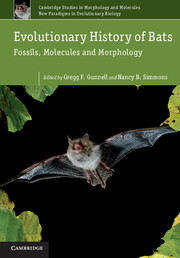Book contents
- Frontmatter
- Contents
- Contributors
- Preface
- 1 Phylogenies, fossils and functional genes: the evolution of echolocation in bats
- 2 Systematics and paleobiogeography of early bats
- 3 Shoulder joint and inner ear of Tachypteron franzeni, an emballonurid bat from the Middle Eocene of Messel
- 4 Evolutionary history of the Neotropical Chiroptera: the fossil record
- 5 New basal noctilionoid bats (Mammalia: Chiroptera) from the Oligocene of subtropical North America
- 6 Necromantis Weithofer, 1887, large carnivorous Middle and Late Eocene bats from the French Quercy Phosphorites: new data and unresolved relationships
- 7 African Vespertilionoidea (Chiroptera) and the antiquity of Myotinae
- 8 Evolutionary and ecological correlates of population genetic structure in bats
- 9 A bird? A plane? No, it's a bat: an introduction to the biomechanics of bat flight
- 10 Toward an integrative theory on the origin of bat flight
- 11 Molecular time scale of diversification of feeding strategy and morphology in New World Leaf-Nosed Bats (Phyllostomidae): a phylogenetic perspective
- 12 Why tribosphenic? On variation and constraint in developmental dynamics of chiropteran molars*
- 13 Necromantodonty, the primitive condition of lower molars among bats
- 14 Echolocation, evo-devo and the evolution of bat crania
- 15 Vertebral fusion in bats: phylogenetic patterns and functional relationships
- 16 Early evolution of body size in bats
- Index
- Plate section
- References
15 - Vertebral fusion in bats: phylogenetic patterns and functional relationships
Published online by Cambridge University Press: 05 June 2012
- Frontmatter
- Contents
- Contributors
- Preface
- 1 Phylogenies, fossils and functional genes: the evolution of echolocation in bats
- 2 Systematics and paleobiogeography of early bats
- 3 Shoulder joint and inner ear of Tachypteron franzeni, an emballonurid bat from the Middle Eocene of Messel
- 4 Evolutionary history of the Neotropical Chiroptera: the fossil record
- 5 New basal noctilionoid bats (Mammalia: Chiroptera) from the Oligocene of subtropical North America
- 6 Necromantis Weithofer, 1887, large carnivorous Middle and Late Eocene bats from the French Quercy Phosphorites: new data and unresolved relationships
- 7 African Vespertilionoidea (Chiroptera) and the antiquity of Myotinae
- 8 Evolutionary and ecological correlates of population genetic structure in bats
- 9 A bird? A plane? No, it's a bat: an introduction to the biomechanics of bat flight
- 10 Toward an integrative theory on the origin of bat flight
- 11 Molecular time scale of diversification of feeding strategy and morphology in New World Leaf-Nosed Bats (Phyllostomidae): a phylogenetic perspective
- 12 Why tribosphenic? On variation and constraint in developmental dynamics of chiropteran molars*
- 13 Necromantodonty, the primitive condition of lower molars among bats
- 14 Echolocation, evo-devo and the evolution of bat crania
- 15 Vertebral fusion in bats: phylogenetic patterns and functional relationships
- 16 Early evolution of body size in bats
- Index
- Plate section
- References
Summary
Introduction
The general shape, function and development of vertebrae tend to be highly conserved among mammals (Vaughan, 1970; Simmons and Geisler, 1998; Hildebrand and Goslow, 2001; Buchholtz, 2007), where the vertebral column is divided into five distinct regions: cervical, thoracic, lumbar, sacral and caudal. Typical mammalian vertebrae consist of a centrum, a neural arch and two pairs of zygopophyses. On the centrum, a pair of dorsally directed pedicles fuse with the lamina to form the neural arch for protection of the spinal cord. An intervertebral disc separates each centrum; it facilitates multiaxial motion and acts as a cushion between adjacent centra (Hildebrand and Goslow, 2001). Although individual vertebrae separated by intervertebral discs typically remain distinctly separate bones throughout life, vertebral bodies may fuse into multibone units.
Characteristic fusions of vertebrae are well known in turtles and birds, but also occur to varying degrees in some mammals. Fusion of three or more vertebrae into a sacrum that articulates to the ilium is a primitive characteristic in mammals; its loss is considered a derived trait (e.g., Flower, 1885; Vaughan, 1970) and is usually seen only in obligate aquatic mammals. In contrast to the loss of sacral fusion, the cervical vertebrae of many cetaceans are cranio-caudally compressed and often fuse into units of two to seven vertebrae, presumably to provide rigidity of the neck (Flower, 1885). In addition, some rodents, such as jerboas (Dipus sagitta), have fused cervical vertebrae. Jerboas use ricochetal locomotion (using only the hind feet for forward propulsion) and fused cervical vertebrae may provide increased surface area for muscle attachment and vertebral column strength to avoid whiplash injury (Hatt, 1932).
- Type
- Chapter
- Information
- Evolutionary History of BatsFossils, Molecules and Morphology, pp. 500 - 529Publisher: Cambridge University PressPrint publication year: 2012
References
- 3
- Cited by



